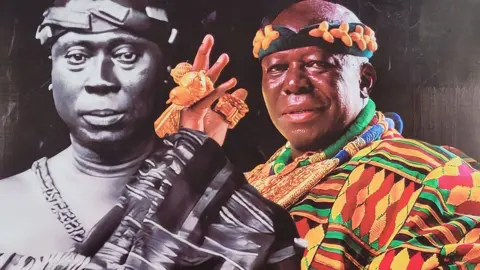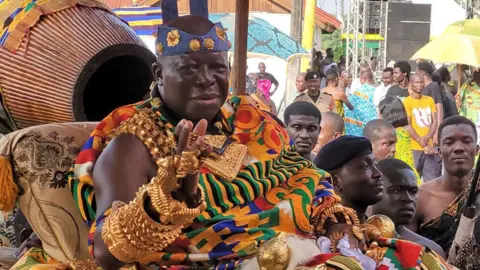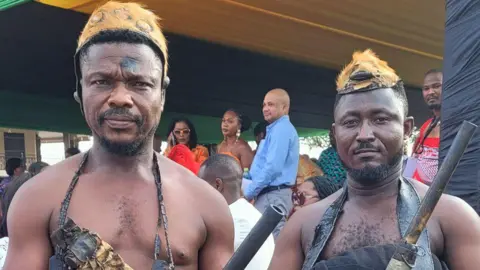To celebrate the king who was exiled by the British to the Seychelles

 Barnaby Phillips
Barnaby PhillipsThe garden outside the king’s palace in the Ghanaian city of Kumasi was filled with a jubilant crowd, celebrating the return of the king who was exiled 100 years ago.
Prempeh was an Asante chief, or “Asantehene”, of the late 19th century who resisted British demands to have his territory swallowed up by the growing Gold Coast protectorate.
A British army from the coast marched about 200 kilometers (124 miles) to Kumasi in 1896, and took Prempeh and about 50 relatives, chiefs and servants as prisoners, and looted his palace.
The prisoners were taken to the coastal fort at Elmina, before being shipped to Sierra Leone, and, in 1900, to the remote Indian Ocean islands of the Seychelles.
It was not until 1924 that the British allowed Prempeh to return home, by which time he was an old man who arrived in Kumasi wearing a European suit and hat.
It is a sad story, but also one of pride and resistance.
“The British did everything they could but they could not break the spirit of Asante,” shouted the host of the event. The current Asantehene, Osei Tutu II, was paraded on his roof in the midst of a crowd, weighed down with fine gold jewellery, amidst the blast of muskets, the beating of drums and the blare of ivory horns.
Asante culture is alive.
 Barnaby Phillips
Barnaby PhillipsBut Prempeh’s exile had a lasting impact on the kingdom of Asante and the Seychelles, although perhaps not in the ways that British officials at the time intended.
The guest of honor at the centenary celebration, which was held in Kumasi at the weekend, was the President of Seychelles, Wavel Ramkalawan, who said “it was an honor, although it is sad, that we received your great king”.
“He showed respect to our people, and he also received the full love of Seychelles,” added Ramkalawan.
Evidence of that is in the family ties that are still cherished today.
Princess Mary Prempeh Marimba is Prempeh’s granddaughter. His grandfather, James, Prempeh’s son, married a Seychellois woman, and initially settled in the islands after his father left.
Mary is a nurse in the capital of Seychelles, Victoria, and she traveled to Kumasi with her daughter Suzy, to reunite with dozens of long-lost relatives and discover more about her Asante heritage.
“There are many mixed feelings, my grandfather had many problems, and this is a painful history, but I am coming here to celebrate with my family,” he said.
Asante exiles in Seychelles lived in “Ashanti Town”, an old sugar plantation, Le Rocher, on the main island of Mahé, overlooking the sea and surrounded by coconut, mango, breadfruit, orange and jackfruit trees .
Prempeh lived in the village, and was given “all respect and dignity”, according to Dr Penda Choppy, a Seychellois scholar who also visited Kumasi for the centenary celebrations.
In 1901, the Asante community grew, as Yaa Asantewaa, the queen who led the last resistance to the British, along with 20 chiefs and ministers, were also sent to Seychelles following their surrender.
 Barnaby Phillips
Barnaby PhillipsThe long years of exile changed Prempeh. He learned to read and write, and urged Asante children to go to school.
He embraced Christianity, and, in the words of Asante historian and politician Albert Adu Boahen, “resolutely and uncompromisingly imposed that religion on other political prisoners and their children”.
In St Paul’s Anglican Church, the Asante were not the only exiles from the church, because they used to live with King Mwanga of Buganda and King Kabalega of Bunyoro, both from present-day Uganda.
Indeed, at various times, the British also sent political prisoners from Egypt, Palestine, Zanzibar, the Maldives, Malaysia and Cyprus to Seychelles, known as the “prison without bars”, since its isolation makes it a complete place, from Britain. opinion, put opponents difficult.
Years went by as Prempeh dreamed of a home.
In 1918, he wrote to King George V and pleaded to be allowed to return.
“Think how sad I am because I was in prison… 22 years now, and now how sad it is to see that father, mother, brother and three-fourths of the kings dead. The remaining quarter, some are blind, some are old. due to old age and some are attacked by diseases variety,” Prempeh wrote.
A few years later, the British, perhaps aware that Prempeh’s possible death in exile would bring political problems to Asante, finally gave up.
In November 1924 Prempeh sailed back to West Africa with about 50 Asante friends, most of whom had been born in the Seychelles.
“We who do not know him long to see his face,” wrote the popular local newspaper, the Gold Coast Leader.
In Kumasi, many slept at the train station to greet him and, according to a British official, “the scene presented by the great assembly . . . , it was a touching and unforgettable sight”.
In theory, “Mr. Edward Prempeh” was now a private citizen, but his people treated him like a king, and gave him royal robes, including the Golden Stool, which is said to contain the soul of the Asante nation.
 Barnaby Phillips
Barnaby PhillipsPrempeh died in 1931, and his successor, Prempeh II, was reinstated as Asantehene in 1935.
Ivor Agyeman-Duah, an Asante scholar and director of the palace museum, helped organize the centenary celebrations.
They had added personal significance, as his grandfather, Kwame Boatin, was one of the exiled chiefs along with Prempeh.
But as Mr Agyeman-Duah acknowledges, deportation, for all its pain, has also brought opportunities to those who suffered.
Kwame Boatin’s children went on to become diplomats and leading civil servants, able to adapt to the dramatic changes that Asante, the Gold Coast and independent Ghana experienced in the 20th century.
“The deportees had been exposed to the world, there was something they could contribute,” he said. “Those who come back with them still inspire us, their dedication to the scholarship and serving the community.”
In a village about an hour’s drive from Kumasi, I met Princess Molly Prempeh, a cartoonist in her 80s, who is Prempeh’s granddaughter.
“I’m the only person left here who was born in Seychelles,” he told me.
“I’m from Seychelles and I’m from Ghana – I was five years old when I came back.”
In her old age, Molly has reconnected with the beautiful islands of her birth, and visited twice.
Seychellois are delighted with the “Old Creole”, which includes many French words, which they remember from childhood.
“When I walk down the street they shout ‘Hey Princess, how are you?’ ‘Princess, venez, venez, tu bien?’ (come, come here, are you ready?) they are lovely people.
But Molly’s visit is also full of sadness. He goes to the grave of his mother, Hugette, who brought Molly as a girl to the Gold Coast in 1948.
Huguette later returned to the Seychelles, where he eventually died.
Even in his old age, the story goes, he loved to speak the Twi language that he had been taught as a child by Prempeh himself.
One family’s story of loss, exile and perseverance.
Barnaby Phillips is a former BBC reporter and author of Loot; British and Benin Bronzes
More BBC news on Ghana:
 Getty Images/BBC
Getty Images/BBCSource link




